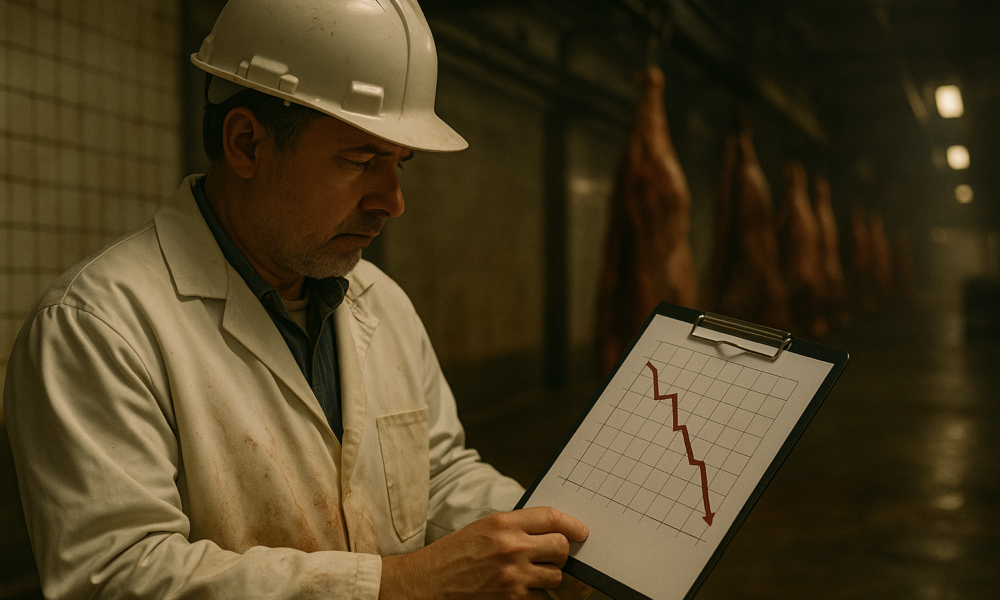Beef Processor Trading Conditions Falter in July

Beef Processor Trading Conditions - July 2025 update
The momentum that beef processors enjoyed through the first half of the year has come under significant pressure in July, with the Beef Processor Trading Conditions (BPTC) index slipping to its weakest point of 2025 so far. After the substantial upward revisions to earlier months, which had lifted the first half average to 83%, July’s downturn has dragged that seasonal average back to 78%. This marks a meaningful deterioration in trading conditions and underscores the volatility that processors face as cost and revenue drivers shift.
The BPTC index, which sits at the intersection of livestock prices, co-product returns, export performance, and domestic retail dynamics, tells a story of margins under siege. The July result of 53% represents a sharp fall from June’s 70% and an even steeper decline from the revised highs seen in May. Where earlier in the year processors had been able to rely on stronger co-product revenues to cushion rising cattle costs, July has exposed just how vulnerable margins remain when input costs rise in tandem with weakening export performance.
The most immediate headwind in July was cattle procurement. Heavy steer prices lifted by 4.2% across the month, young cattle were up by 3.7%, and processor cows surged a hefty 14.0%. These increases came at a time when throughput requirements remained steady, leaving processors with little choice but to absorb higher purchase costs.
In previous months, co-product revenues from offals and pharmaceutical by-products had helped offset these cattle price lifts, but that relief was not evident in July as data is not yet updated for several co-product items, amplifying the impact on the index. Rising cattle values are a double-edged sword for the industry. They speak to stronger farm-gate returns and the pull of international demand for Australian beef, but they erode processor margins almost immediately, especially when export revenue growth does not keep pace.
On the revenue side of the ledger, July offered little reprieve. The top four export markets saw average export values slip by around 1.1% for the month. This decline may appear modest in isolation, but when combined with rising input costs, the effect on processor margins is magnified. The United States provided a slight bright spot, with average export values lifting by 0.7%. South Korea also delivered a positive performance, up 1.8%. However, these gains were more than offset by softness elsewhere. Japan, usually one of the largest and most stable buyers of Australian beef, recorded a sharp 5.6% fall in average export values. China also eased, with a 1.7% decline. This mixed export profile reflects both the highly competitive global beef trade and the challenges posed by currency fluctuations, shifting consumer demand, and alternative protein availability.
The result is that processors have found themselves squeezed from both ends due to higher cattle costs on the one side and softer export returns on the other. The BPTC index of 53% is not only below the healthy green trading conditions zone but signals a deterioration that warrants attention. The industry has moved from a position of relatively comfortable profitability earlier in the year to one of fragile balance, where even minor changes in export demand or livestock pricing can pressure margins.
This fall in July also demonstrates the precariousness of the revisions that boosted earlier months. May’s strong upward revision, from 71% to 87%, had painted a picture of resilience and hinted that processors were better positioned than first thought. However, the July results show how quickly that resilience can be tested. The seasonal average of 78% remains respectable by long-term standards, but the trajectory is downward, and the prospect of further cost increases or export volatility looms.
For beef processors, the situation demands renewed focus on efficiency, market diversification, and co-product utilisation. The collapse in pharmaceutical by-product revenues during June was a reminder of how critical these streams are to overall margins. Without robust co-product contributions, processors are left heavily exposed to swings in cattle and beef prices. While July’s export and domestic retail results did not provide catastrophic losses, the marginal declines combined with cattle price rises were enough to erode profitability. It highlights how narrow the buffer can be when multiple factors shift even modestly in the wrong direction.


